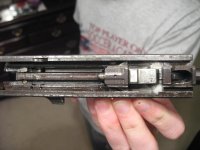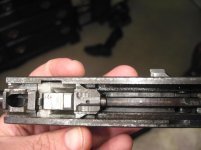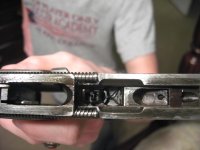The plunger in the locking block Clark is present and working, it looks just like the pic u posted. No worries on disassembly and reassembly Jim, I've had this pistol apart and back together so many times over the last few days i can do it blind folded. I am absolutely convinced the spring guide rods are too short. I ordered 2 this morning so as soon as they arrive I will put them in and hopefully that will be the end of it. This has certainly been a good learning experience.
You are using an out of date browser. It may not display this or other websites correctly.
You should upgrade or use an alternative browser.
You should upgrade or use an alternative browser.
Help with a Mauser P38
- Thread starter erob3
- Start date
I compared them to other pics on this thread also and even counted the number of coils on the spring to the end of the guide rod and mine are the same length. That's the only thing it can be though Clark, there is no other reason the slide would or could go back farther than it is supposed. I'm not a gunsmith but it just seems like common sense to me, the guide rods control how far the slide can go back. If they are too long the slide will not go back far enough, too short it goes back too far. Right or wrong? Please weigh in more, I'm still learning here.
Jim, I just looked at pic #5 again. I am putting the barrel in the slide and putting them on the frame together. In pic #5 the locking block pushes up like that when you rack the slide, it just pulls back too far and allows the locking block to go up.
Jim, I just looked at pic #5 again. I am putting the barrel in the slide and putting them on the frame together. In pic #5 the locking block pushes up like that when you rack the slide, it just pulls back too far and allows the locking block to go up.
Last edited:
OK. I finally got off my fat butt and dug out a few of my P.38s. Your recoil spring guides must be 1.190" +or- .003" or so.
The recoil springs compress fully on the guides, and the guides "bottom out" against the ends of the recoil spring tunnels.
If your guides are too short, they are allowing the slide to travel rearwards too far, thus allowing the locking block to pop up against the front of the slide.
So...Pull your guides out, get your dial caliper and measure their length. If they are substantially shorter than 1.190 (+or-), then there's your problem.
The recoil springs compress fully on the guides, and the guides "bottom out" against the ends of the recoil spring tunnels.
If your guides are too short, they are allowing the slide to travel rearwards too far, thus allowing the locking block to pop up against the front of the slide.
So...Pull your guides out, get your dial caliper and measure their length. If they are substantially shorter than 1.190 (+or-), then there's your problem.
For the fun of it, I took the springs and guides completely out of my P1, so the slide goes back as far as it possibly can. I can get the barrel into the position shown in #5, and I think I see what is happening. Those guides would have to be at least 1/8 inch too short.
I also checked on the spring going solid and the guides do stop the slide, not the springs.
Jim-
I also checked on the spring going solid and the guides do stop the slide, not the springs.
Jim-
Winchester_73
New member
1) Is there a specific finish to a Duo Tone Mauser?
There were no "dual tone" P.38's as such; somtimes the different machining of slide and frame made them appear different but they weren't supposed to be.
There were later war phosphate P38s made by Mauser which had a phosphate frame and slide but a blued barrel (usually - when the barrel is also gray phosphate, they are "Gray Ghosts" and highly sought after). I think some people would consider this a dual tone even though its combining a dull phosphate finish with standard blue.
4) Lastly he is greatly interested in the value. I have checked gunbroker and found these selling for $900 or so up.
Byf 44s are one of the most common P38s. Mauser started putting out P38s in 1942 and by 1944 they were able to make well over 100K for that year. BYF was simply the Mauser manufacturer's code. Later it was changed to SVW code, but still a Mauser. Other makers include: AC or 480 for Walther and CYQ for spreewerke. Since the gun is a BYF 44, it would need to have a holster and 2 mags in addition to having 90% finish to bring $900. In other words, even nice, its just too common a variation.
Even if you replaced the grips and got it working properly, its still worth $400 tops and now $300 tops. They're neat guns and shoot well. Don't be afraid to shoot it after its repaired.
the guys at this forum have been extremely helpful in getting mine up and running http://p38forum.com/
Once you get the bugs worked out have fun shooting it. I always get a lot of questions and discussion on the range when I bring mine out.
Joe
Once you get the bugs worked out have fun shooting it. I always get a lot of questions and discussion on the range when I bring mine out.
Joe
Hi, Winchester 73,
You are correct on the very late war guns, when they were throwing together any parts that would fit or could be made to fit. They even used parts out of the scrap dump that had been rejected earlier, so some really odd pistols were made in that timeframe.
I admit I was thinking of the modern "dual tone" pistols, where slide and frame are made with different materials or finishes for show; in that sense, there were no "dual tone" P.38's.
Jim
You are correct on the very late war guns, when they were throwing together any parts that would fit or could be made to fit. They even used parts out of the scrap dump that had been rejected earlier, so some really odd pistols were made in that timeframe.
I admit I was thinking of the modern "dual tone" pistols, where slide and frame are made with different materials or finishes for show; in that sense, there were no "dual tone" P.38's.
Jim
One quick question while I'm waiting on the new guide rods. If anyone would take the time to check and see if yours does this it would be great. When putting just the barrel / receiver on the frame, locking it into position with the locking block in place, and WITHOUT THE SLIDE; can the barrel / receiver be pulled forward and the locking block rise upward? Just checking to see if this is normal for these guns.
Thanks.
Thanks.
m.p.driver
New member
Need a parts set,Centerfiresystems has them for $89.99.Everything but the receiver and barrel.
Hi, Erob3,
The locking block is cammed up by the frame and down by the pin striking the frame so yes, it will work with just the barrel in the frame; the slide has no role in moving the block up and down.
I am not sure what you mean by the receiver; the receiver and the frame are the same. The P.38 barrel is one piece*, not like the Luger where the barrel is screwed into the part called the receiver.
*Postwar alloy guns have a steel barrel liner, but it is a permanent assembly so there is still effectively one piece.
Jim
The locking block is cammed up by the frame and down by the pin striking the frame so yes, it will work with just the barrel in the frame; the slide has no role in moving the block up and down.
I am not sure what you mean by the receiver; the receiver and the frame are the same. The P.38 barrel is one piece*, not like the Luger where the barrel is screwed into the part called the receiver.
*Postwar alloy guns have a steel barrel liner, but it is a permanent assembly so there is still effectively one piece.
Jim
Thanks Jim, it is my lack of knowledge that I'm sure is making this process more difficult. I will try to describe this more clearly. When I put the barrel on the frame without the slide, after I lock the barrel in place I can move the barrel forward and backward on the slide. As I push it forward the locking block rises, then when I pull it backward the locking block pin of course pushes in allowing the locking block to go back down. Is it normal to be able to move the barrel back and forth on the frame like that or should it be locked in place and not move at all?
If I read you right, that is completely normal operation.
Upon firing, the barrel travels backwards a short distance, locked to the slide (the locking block in the "up" position with its lugs engaged with corresponding slots in the slide).
At the end of its (the barrel) travel (after chamber pressures have dropped to safe levels), the locking block is cammed down by the large pin hitting the abutment on the frame, forcing the lugs downward OUT of engagement with the still rearward traveling slide.
The rearward travel of the barrel is halted, but the slide, having been freed from the barrel, continues to travel rearward, completing the ejection and cocking cycles.
After completing its rearward travel, the slide then continues its cycle of operation and starts traveling forward. Upon contacting the breech face of the barrel assembly, it then forces the barrel forward until the locking block is forcibly cammed upward by a ledge in the frame into engagement with the slide once again, securely locking the barrel to the slide.
I hope you get your new recoil spring guides soon, because we are all anxious to see if that was the problem.
Upon firing, the barrel travels backwards a short distance, locked to the slide (the locking block in the "up" position with its lugs engaged with corresponding slots in the slide).
At the end of its (the barrel) travel (after chamber pressures have dropped to safe levels), the locking block is cammed down by the large pin hitting the abutment on the frame, forcing the lugs downward OUT of engagement with the still rearward traveling slide.
The rearward travel of the barrel is halted, but the slide, having been freed from the barrel, continues to travel rearward, completing the ejection and cocking cycles.
After completing its rearward travel, the slide then continues its cycle of operation and starts traveling forward. Upon contacting the breech face of the barrel assembly, it then forces the barrel forward until the locking block is forcibly cammed upward by a ledge in the frame into engagement with the slide once again, securely locking the barrel to the slide.
I hope you get your new recoil spring guides soon, because we are all anxious to see if that was the problem.
Here is a link for an animated view of the p38 firing and reloading sequence. This may help to visualize how the various parts are working together.
http://www.p38forum.com/anime7.swf
Joe
http://www.p38forum.com/anime7.swf
Joe



